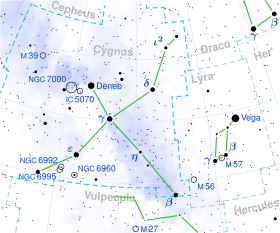P Cygni star
| Observation data Epoch J2000 Equinox J2000 |
|
|---|---|
| Constellation | Cygnus |
| Right ascension | 20h 17m 47.2018s |
| Declination | +38° 01′ 58.549″ |
| Apparent magnitude (V) | 4.82 (3 to 6) |
| Characteristics | |
| Spectral type | B1Ia+ |
| U−B color index | -0.58 |
| B−V color index | +0.42 |
| Variable type | LBV |
| Astrometry | |
| Radial velocity (Rv) | -8.9 km/s |
| Proper motion (μ) |
RA: -3.53 mas/yr Dec.: -6.88 mas/yr |
| Parallax (π) | 0.32 ± 0.16mas |
| Distance | 1,700pc |
| Absolute magnitude (MV) | −7.9 |
| Details | |
| Mass | 30 M☉ |
| Radius | 76 R☉ |
| Luminosity | 610,000 L☉ |
| Surface gravity (log g) | 1.2 cgs |
| Temperature | 18,700 K |
| Metallicity | 0.29 He/H |
| Rotational velocity (v sin i) | 35 km/s |
| Other designations | |
|
Nova Cyg 1600, 34 Cyg, JP11 3218, TD1 26474, GSC 03151-03442, TYC 3151-3442-1, AG+37° 1953, 2MASS J20174719+3801585, ALS 11097, HD 193237, MCW 849, BD+37° 3871, Hen 3-1871, PLX 4837, CEL 5017, PPM 84645, P Cyg, RAFGL 5493S, GC 28218, HIP 100044, ROT 2959, GCRV 12673, HR 7763, SAO 69773, AAVSO 2014+37A.
|
|
| Database references | |
| SIMBAD | data |
P Cygni (34 Cyg) is a variable star in the constellation Cygnus. The designation "P" was originally assigned by Johann Bayer in Uranometria as a nova. Located about 5000 to 6000 light-years (1500–1800 parsecs) from Earth, it is a hypergiant luminous blue variable (LBV) star of spectral type B1Ia+ that is one of the most luminous stars in the Milky Way.
The star is located about 5000 to 6000 light-years (1500–1800 parsecs) from Earth. Despite this vast distance, it is visible to the naked eye in suitable dark sky locations. It was unknown until the end of the 16th century, when it suddenly brightened to 3rd magnitude. It was first observed on 18 August (Gregorian) 1600 by Willem Janszoon Blaeu, a Dutch astronomer, mathematician and globe-maker. At this time it was given a Bayer miscellaneous label P and the name has stuck ever since. After six years the star faded slowly, dropping below naked-eye visibility in 1626. It brightened again in 1655, but had faded by 1662. Another outburst took place in 1665; this was followed by numerous fluctuations. Since 1715 P Cygni has been a fifth magnitude star, with only minor fluctuations in brightness. Today it has a magnitude of 4.8, irregularly variable by a few hundredths of a magnitude on a scale of days. The visual brightness is increasing by about 0.15 magnitude per century, attributed to a slow decrease in temperature at constant luminosity.
P Cygni has been called a "permanent nova" because of spectral similarities and the obvious outflow of material, and was once treated with novae as an eruptive variable; however its behaviour is no longer thought to involve the same processes associated with true novae.
...
Wikipedia

